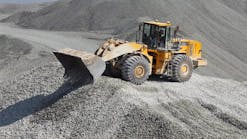By: Kathe Tanner
Source: The Tribune (San Luis Obispo, Calif.) (TNS)
Apr. 17—Caltrans has a pair of big, new remote-control tools in its road-repair kit, and they’re being used for the first time as the agency works to clear a stubborn landslide that closed Highway 1 near Big Sur.
Workers are now operating two remote-controlled D-8 Caterpillar [dozers] at the Regent’s Slide site on Big Sur, according to a release the agency sent out Thursday.
But even with the high-tech help, Caltrans still expects repairs there will keep the scenic highway closed through summer of 2025.
The slide site is about 27 miles north of the county line dividing Monterey and San Luis Obispo counties.
The innovative new technology, designed in conjunction with Caterpillar Inc. and other contracting partners, “is intended to increase production and protect worker safety at Regent’s,” Caltrans said in the release.
At the precarious site, “crews are challenged by the height, steepness and instability of the slide.”
The equipment was delivered to the site by helicopter in February, Caltrans spokesman Kevin Drabinski told The Tribune on Thursday. “They began training on the equipment in early March” and began using it on the slide soon thereafter.
The bulldozer and excavator operators trained to use the remote equipment “that can perform under certain adverse site conditions and at locations that may otherwise not be safe for crews to operate,” the release added.
The capabilities of the remote-controlled equipment “will be used to complement ongoing traditional repair strategies.”
How operators control the machinery
The equipment can be operated two ways, Drabinski said.
“They can operate them from a trailer that’s 1,000 feet away,” using camera feeds from the equipment to guide their actions.
Or, where terrain and conditions allow, he said, operators can wear a harness and get closer to watch and direct the equipment from a safe distance, but within visual sight of the device.
Because of the nature of the site and the unpredictability of the slide action, Drabinski said, there are always spotters working at the bottom, monitoring for any movement, so they can alert the workers at the top.
“A catastrophic event will happen from the bottom,” he said, so those alerts are crucial.
The area’s rapidly changing weather also plays a part, Drabinski said.
“Access is iffy,” he said. “If it’s too foggy at the top and the spotters can’t see the top, work stops.”
Those site conditions also determine when the highly trained crews can use the new equipment.
The original slide in February 2024, about 450 feet above the highway, released about 300,000 cubic yards of rock and dirt onto and around the Great American Road that travels through Big Sur and what’s acknowledged as some of the most spectacular coastal scenery in the world.
A new landslide, which enveloped the repair site in August 2024 and extended the closure indefinitely, continues to move at over one foot per day.
“The new slide caused cracking below and above, so they had to begin excavation above the new slide. For worker safety, we can never put them across the new cracks,” the spokesman said. “Now, we’re able to clear in areas where we could never send crewed machinery.”
Caltrans continues to perform daily geologic assessments to determine if it is safe to conduct repair work, the release said. Given those conditions, the introduction of remote-controlled equipment will allow Caltrans to take more risk than would be advisable with crewed dozers and excavators.
What’s open along Highway 1?
Visitors can still access more than 100 miles of Highway 1 between Cambria and Carmel, except for the 6.8-mile closure from a mile south of the Esalen Institute to two miles north of Lucia.
Businesses on both ends of the closure are open and geared up for the holiday and summer seasons.
“Travelers from Southern California can reach the endearing communities of Lucia, Gorda, Ragged Point, San Simeon and Cambria via Highway 1,” the release said. “Travelers from Northern California can still access historic bridges, waterfalls, restaurants, and lodging amenities along the Big Sur coast.”
© 2025 The Tribune (San Luis Obispo, Calif.).
Visit www.sanluisobispo.com.
Distributed by Tribune Content Agency, LLC.





